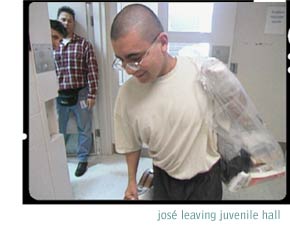 |


Fifteen year-old José's childhood was difficult: his father, a heroin addict,
disappeared shortly after José was born, and his mother had problems of her own
and eventually disappeared as well. And eventually, Jose became involved with a local gang. He also became a serious addict, hooked on
both drugs and alcohol.
In the fall of 1998 José participated in a deadly brawl. He and four other
teenagers -- two of them recent immigrants from Mexico - had been hanging out
in an alley, drinking. The teenagers started roughhousing and this
escalated into serious fight, with the two immigrants becoming targets of the
others. The skull of one of them was crushed, after being beaten repeatedly. The other escaped by scaling a fence, breaking his ankle
in the process. José and his friends fled the scene as the neighbors awoke to
the commotion.
José was arrested and charged with murder. Prosecutors asked for a fitness
hearing to determine if he could be tried in adult court, because of the seriousness of the crime. As prosecutor Kurt Kumli explained, "He had been in the system since he was twelve years old, and he committed a crime of such violence, of such callousness, that it really begged under the statutory scheme set out for fitness to be certified up . . . ."
Upon investigation, however, more facts began to emerge about José's case.
After fleeing the scene of the assault, José and his friend had found the second
victim struggling to walk with a broken ankle, and they helped the victim to
get home and clean up. It was also discovered that while José had participated
in the beating, he appeared to have
played a lesser role in the attack. These factors, combined with his youth and
severe intoxication on the night of the incident, led prosecutors to offer José a
deal. Prosecutor David Soares said, "We looked at what was the level of
participation in the assault, how criminal was he, how culpable was he. And in
José's case . . . we saw that his involvement wasn't that high." So José was
offered a deal: he was to move to adult court and plead guilty, but to a lesser
charge of involuntary manslaughter. After his plea, José was sent for a
psychological evaluation at the California Youth Authority. He received a favorable evaluation in which the psychologist found that he was not likely to be a threat to public safety as long as he was sober.
 The judge gave José a very big break -- sentencing him to only 208 days in
Juvenile Hall. While he was there, José worked hard at school, graduating shortly before his release. He became a favorite of the staff; as teacher
Joe Mangelli explained, "He did a lot of it on his own. The raw material was
there. He didn't have to start from ground zero. He had a great personality
and intelligence and openness, and I think the staff around here filled in the
gaps for him and helped him to succeed, hopefully forever."
The judge gave José a very big break -- sentencing him to only 208 days in
Juvenile Hall. While he was there, José worked hard at school, graduating shortly before his release. He became a favorite of the staff; as teacher
Joe Mangelli explained, "He did a lot of it on his own. The raw material was
there. He didn't have to start from ground zero. He had a great personality
and intelligence and openness, and I think the staff around here filled in the
gaps for him and helped him to succeed, hopefully forever."
Released from juvenile hall at 17, José now carries an adult record. As
conditions of his probation, he had to cut all ties with his gang life, submit
to drug tests and either find a job or go to school full time. After five
months of rejections, and with the assistance of a nurse from the juvenile
hall, José obtained a job with a local parks department. He enrolled in community college after the staff from juvenile hall
helped him get books and a bicycle to get to class.
Update: In late January 2001, Jose was arrested for a probation violation. He is currently in county jail and will appear in court
sometime in February.

manny · shawn · marquese · jose
from both sides of the bench · facts & stats · related report: little criminals
discussion · synopsis · press · tapes & transcripts · credits
FRONTLINE · wgbh · pbs
web site copyright WGBH educational foundation
|  |